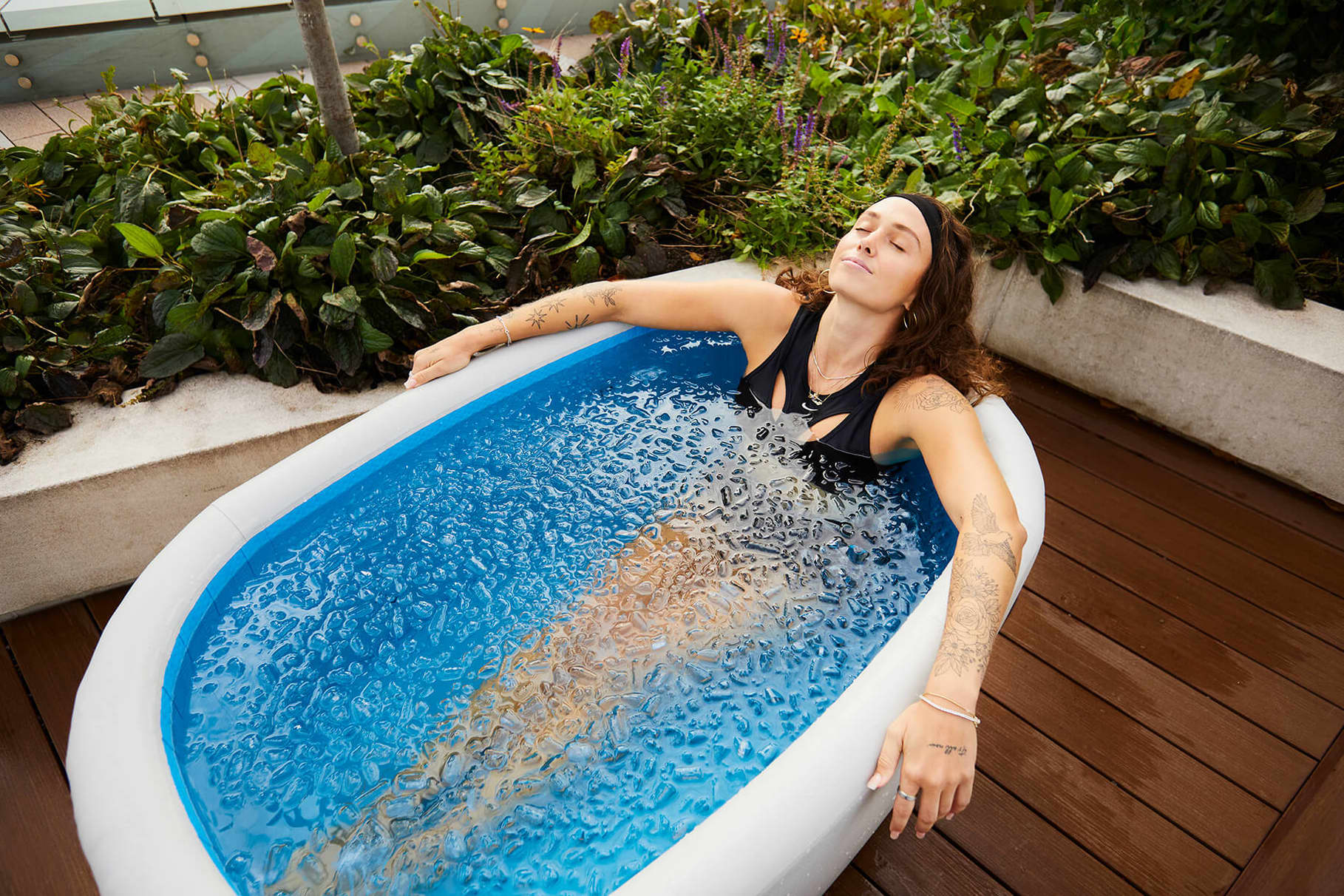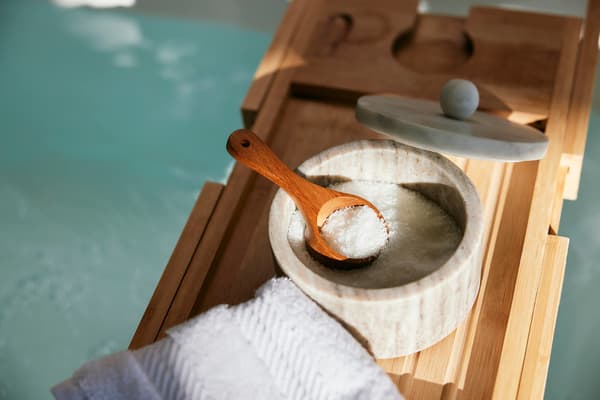5 ice bath recovery benefits you need to know about
Sport & activity
Here's how cold water immersion can support athletic performance—and overall health.

Ice baths have long been used by athletes looking to speed up their recovery time after intense exercise and to boost their athletic performance. While the recovery method dates back to ancient Greece, it's more popular and accessible than ever right now.
Are ice baths the recovery modality your fitness routine has been missing? And how do they work, exactly? Ahead, Nike Well Collective performance coach, Lauren Schramm, ACE-certified personal trainer and creator of Ice Cold Club in New York, New York (where she coaches weekly ice bath sessions), and Laura Barreca, DPT, answer all of your questions. They also share potential ice bath recovery benefits you could experience post-workout.
Plus, you'll get to learn about what the research says about general ice bath benefits, including improving sleep, stress and overall well-being.

What is an ice bath?
Just as it sounds, an ice bath quite literally involves filling a bath with multiple bags of ice cubes and cold water or using an ice-plunge-specific tub.
"Ice baths are a form of cold water immersion, or CWI, a sports therapy method used to minimise fatigue and speed up the post-exercise recovery process", Barreca said. "CWI often involves immersing yourself in a very cold bath or pool—specifically, less than 15 degrees Celsius", she said.
"The theory behind hopping in an ice bath right after a workout is that the cold temperature slows down blood flow in the body to help blood flow re-circulate at a quicker speed when returning to room temperature", Barreca said. "This increase in circulation allows blood flow to move at a faster rate to damaged muscle helping to aid in healing processes as well as reducing muscle inflammation".
It could be just a quick dip or plunge, a several-minute-long full-body submersion or a soak for just one or two body parts (think: your arms or legs).
However, research shows that 11–15 minutes is the ideal amount of time to stay immersed to reap the post-workout recovery benefits. More on how to build up to that (and why you should) below.
What are the potential benefits of an ice bath?
"Overall, the research on CWI—particularly, ice bath recovery benefits—is limited, Additionally, most studies on this topic were conducted on elite athletes", Barreca said. There is strong anecdotal evidence to support the mind-body benefits of taking an ice bath—or even a cold shower.
1. It cools down your body
Think about it: if you exercise in high temperatures, or if you tend to overheat when exercising on hot or humid days, taking an ice bath can help quickly cool your body down after a workout.
A review, published in a 2015 issue of Medicine & Science in Sports & Exercise, found that just 10 minutes spent in an ice bath of around 10 degrees Celsius can effectively treat exercise-induced hyperthermia when the body overheats to the point of experiencing heat exhaustion or heat stroke.

2. It can help reduce muscle soreness
"Ice baths are used by elite athletes for their ability to speed up recovery time and reduce delayed onset muscle soreness, which is a side effect of the muscle repair process", Barreca said.
According to the American College of Sports Medicine, intense exercise (whether that's heavy weightlifting, high repetition volume of an exercise or working out for a longer-than-usual period) causes microscopic tears to the muscle fibres. Your body responds to this damage by increasing inflammation, which may lead to the soreness you feel a day or two after exercise.
One meta-analysis of nine studies, published in a 2015 issue of Sports Medicine, concluded that CWI therapy has a more positive effect on muscle soreness than passive recovery (complete rest) in terms of immediate and delayed effects.
Just bear in mind that you can reap most of the ice bath benefits after a tough workout. "You want to use it when your muscles are damaged", Barreca said. For context, intense workouts or increasing the volume of your workouts can cause microtears in muscle fibres. As a result, inflammation begins the healing and regeneration process of said fibres.
"As an example, runners might benefit from an ice bath after a particularly long or hard run, or a week of high volume or high mileage", Barreca said.
She also pointed out that the primary takeaway of most studies on CWI is that it can help with perceived fatigue levels. In other words, if you feel as though an ice bath makes your muscles feel recovered, that's great. "However, there's no need to force it with so many other recovery methods out there", Barreca added.
A study—found in a 2017 issue of the Journal of Physiology—compared the use of ice baths and active recovery, such as swimming, foam rolling or stretching to reduce muscle soreness after exercise. The researchers unveiled that CWI was no more effective than other active recovery methods at lowering post-exercise inflammation. Instead, they concluded this recovery method could be useful in competition settings with a short turnaround time (think: CrossFit athletes between events).
3. It could help you sleep more soundly
If you've ever pulled an all-nighter, you know that sleep is responsible for even basic cognitive functioning—it makes sense that it's a crucial part of any athlete's performance and recovery. Research shows that slow-wave sleep (often referred to as deep sleep) allows for muscle repair, too.
At the same time, thermoregulation—the process that enables your body to maintain its core internal temperature—is a crucial component of sleep. The body's core temperature naturally drops during sleep, which is why you may have heard that a cooler room makes it easier to fall and stay asleep. For the same reason, ice baths, which decrease your body's temperature, could be beneficial when it comes to improving our sleep quality.
A small 2021 study of male endurance runners found that whole-body CWI reduced arousal (an uptick in brain activity during sleep) and limb movements (repetitive muscle movements that can disrupt sleep) and had a positive effect on slow-wave sleep. The study authors concluded that CWI (which, in this instance, includes a cold shower) close to bedtime may help enhance sleep and neuromuscular recovery after high-intensity exercise.
4. It could help boost your immune system
There's some evidence that suggests athletes who regularly swim in cold water experience fewer and milder viral infections. While the jury is still out on whether that means taking an ice bath could help you catch fewer colds, it's plausible considering the theory that short-term physiological stress—such as cold water exposure—prepares the immune system to fight infections.
Researchers are continuing to explore whether the shock of immersing yourself in cold water can stimulate leukocytes, the blood cells that fight off infection.
A small 2014 study—based on the case study of Wim Hof (a Dutch extreme athlete who holds the record for 80-minute full-body ice immersion)—found that by practising techniques including CWI, you might be able to strengthen your body's ability to fend off infectious diseases, such as the common cold.
In the study, participants who were trained for just 10 days on meditation, breathing techniques and exposure to cold (including submersion in water) had fewer flu-like symptoms than those who weren't trained. While it's hard to isolate the impact of CWI specifically, it's certainly an argument for "practice makes perfect"—even with your recovery routine.

5. It might help relieve stress and build mental resilience
Anecdotally speaking, people have reported that cold water therapy can provide mental health benefits.
"If I'm ever feeling anxious or stressed about a situation, I will stop whatever I'm doing and go into a cold shower for two minutes, and I'll come out and have a different mindset", Schramm said.
A 2020 study in the International Journal of Environmental Research and Public Health found that cold water swimming (or ice swimming) can have psychological benefits like decreased tension, fatigue and negative mood states as well as improved general well-being.
"The theory behind this is that CWI stimulates the part of the nervous system that regulates the fight-or-flight stress response", Schramm said. Doing CWI regularly may dampen that response, which in turn, may help people feel better able to handle other stresses in their lives.
Schramm said ice baths are, "a way to stress out the mind and the body. It's an opportunity to practise how you handle stress, and that translates to your regular life".

How often should you take ice baths? (And how long do you need to stay in?)
Barreca recommended taking an ice bath one to two times per week maximum. However, she added that some people may see other health benefits from a daily routine if that's accessible to them. Schramm hops in an ice bath every day for the mental health benefits or takes a cold shower if she's travelling.
With her ice bath clients, Schramm follows the recommendation from Susanna Søberg, a researcher from Denmark, of 11 minutes per week. Usually, this is divided into three, 3.5-minute sessions.
"Building up to even just a few minutes is easier said than done, but it's worth holding out until the three-minute mark—which is when the numbing effects kick in—and it starts to feel easier", Barreca said. She added that the optimal time for recovery benefits is 11 to 15 minutes per session.
What are the risks of taking ice baths?
Ice baths can come with certain risks. "If you have a pre-existing health condition, it's a good idea to get clearance from your doctor first", Schramm said.
"For example, ice baths can also be dangerous if you have high blood pressure or cardiovascular disease, an open wound or a condition that increases your cold sensitivity or causes impaired circulation", Barreca said. "Children and anyone pregnant should also skip", she added.
"If you don't have a condition that would prevent you from trying an ice bath, the main risk is hypothermia, a medical emergency that occurs when your body loses heat faster than it can produce heat, and it can happen if you stay in for too long", Barreca said.
"Think about what's happening to your body: blood flow is slowing down and circulation is slowing down. So, you don't want to stay longer than 15 minutes", she said.
It's also important to never take an ice bath alone, especially if it's your first time. It's equally important to look out for signs of hypothermia or cold shock. If you're feeling light-headed or dizzy or experiencing intense shivering, get out of the water immediately.
And remember, only try an ice bath if you want to do one—not just because someone says it works for them. "If you are someone who is claustrophobic or doesn't like to be cold, you're probably not going to enjoy being in it—and you don't need to suffer through that", Barreca said.
Ice bath vs cold showers
"You can make an ice bath at home, but without dumping loads of ice into your bath, it can be hard to get it cold enough (below that 10-degree Celsius mark)", Barreca said.
And while you can purchase an at-home ice bath to ensure the water stays cold and clean, they can be pricey.
"You don't need to go out and buy a tub", Schramm said. Her approach to her ice bath workshops is to help people feel better equipped to implement the practice wherever they go. Whether that's a cold plunge at a spa, jumping in a lake or the ocean, or taking a cold shower at home or while travelling.
Research even shows that cold showers could provide similar benefits to an ice bath. In one small study of elite netballers, 14 minutes of contrast showers (alternating hot and cold each minute) after training led to a similar perception of enhanced recovery as contrast baths (brief, repeated immersions in water, alternating between warm and cold temperatures).
"Here's how to try it: after taking your normal shower, step out of the water, turn the water to cool (it doesn't have to be freezing) and then take a full breath in and a full breath out", Schramm said. On the second breath, inhale, hold it and then step into the water.
So, should you take an ice bath?
Even though some studies have shown an association between ice bathing and certain health benefits, it's not right for everyone—and that's OK. If you decide to try CWI, check with your doctor and then try it in a controlled environment with the help of a trained expert.
And if you do find that ice baths work for you, continue to practise other smart recovery techniques, too. Barreca said ice baths are "not a quick fix or a one-time fix situation". It's still important to, for example, foam roll or get sports massages. "And if you're dealing with an injury, it doesn't replace going to a physiotherapist", Barreca said. "It's supposed to be supplemental—not working in isolation".
Words by Kylie Gilbert















